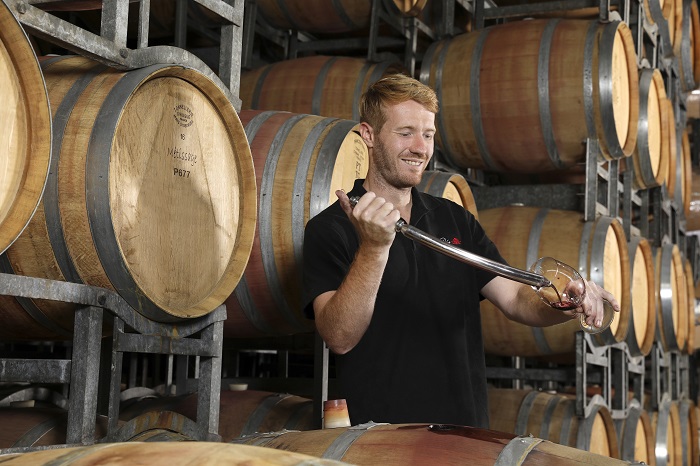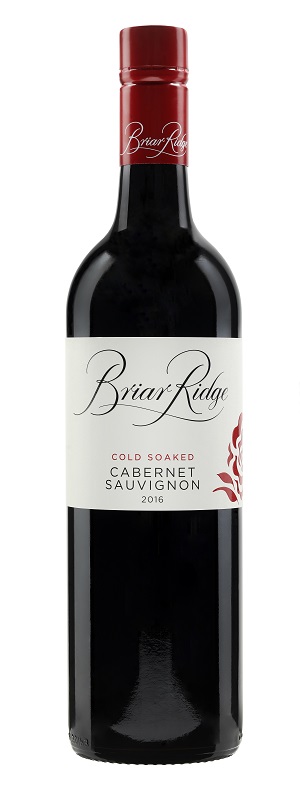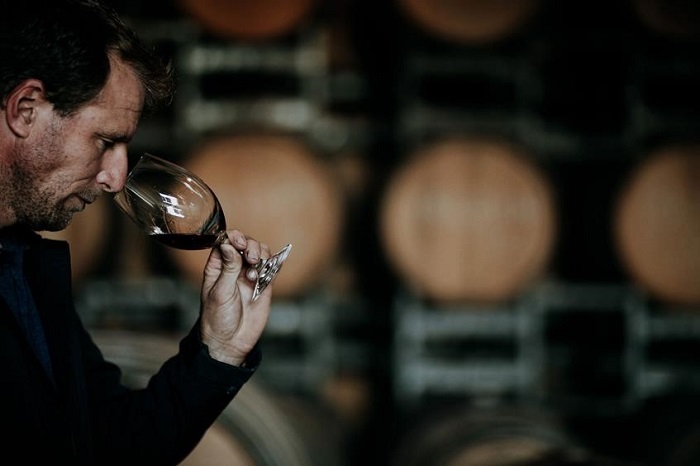Cold soaking, also known as cold maceration, is a common method used by winemakers to extract colour and flavour from mostly red grape skins. While extraction also occurs during fermentation, many winemakers feel cold soaking brings out different aspects of grapes. There is some debate among winemakers about the overall benefits to wine, so Eleanor Danenberg invited winemakers from the Hunter Valley, Great Southern, Piccadilly, and Central Otago to have their say on why they cold soak, what varieties they cold soak, how they do it, and what results they notice. This article was originally published in the September issue of the Australian & New Zealand Grapegrower & Winemaker magazine.
Rob Diletti Castle Rock, Great Southern, WA
What are the main reasons that you cold soak?
I did an informal trial of one tank of Pinot Noir grapes cold soaked, and one tank not. I preferred the cold soaked tank as I found I got better colour from cold soaking.
Which varieties do you normally subject to cold soaking?
Pinot Noir and Shiraz. From where do you source the grapes that you cold soak? All our fruit is from the Porongurup subregion of the Great Southern, so pretty cool climate.
Do you cold soak as a matter of course or are there certain parameters that must be reached first before you make the decision to use it?
Yes, as long as the fruit is in good condition, with no disease. Due to good vineyard management, I haven’t had to worry about this for quite a few years, but I wouldn’t cold soak if there was a lot of botrytis in the vineyard.
Describe your cold soak methods.
I cold soak with destemmed fruit. I use an enzyme to assist with colour extraction and filtration prior to bottling, and I use sulfur dioxide and carbon dioxide. I cold soak in six-tonne stainless steel fermenter tanks. To get the temperature down I pump through a heat exchanger and then use cooling jackets. Then, the juice is held at somewhere around 5-8°C, and chilled for between four-seven days.
What have been, or are, the challenges in getting the most out of cold soaking and how have you attempted to overcome them?
The appearance of spoilage characters; some are okay, but sulfur dioxide helps to keep them to manageable/desirable levels. After about four to five days I usually start seeing a bit of volatile acidity; I don’t mind a little bit, but I will inoculate with yeast and let the tank warm up when I see it.
Castle Rock winemaker Rob Diletti is pictured above.
Olly Masters Misha’s Vineyard, Central Otago, NZ

What are the main reasons that you cold soak?
Generally all our Pinot ferments start naturally. By cold soaking we generally avoid some of the volatile acidity issues you can see otherwise. I also prefer the tannin integration that extended total tank time gives — cold soak is a good way to do this, i.e., avoiding oxidative opportunity.
Which varieties do you normally subject to cold soaking?
We usually just do cold soaking with Pinot Noir. We do give some of our whites varying levels of skin contact, Pinot Gris and Riesling being the main ones — but generally only for a few hours.
From where do you source the grapes that you cold soak?
All Misha’s Vineyard fruit is sourced from our own single vineyard site on the Bendigo Station in Central Otago which is a cool climate area, and uniquely New Zealand’s only semi-continental grapegrowing area.
Do you cold soak as a matter of course or are there certain parameters that must be reached first before you make the decision to use it?
Generally our night time temperatures and fruit condition at harvest allow us to cold soak without extra chilling. Depending on vintage, ambient temperatures with the initial cold soak might be anywhere from 8-12°C.
Describe your cold soak methods.
Cold soak is a method we use often use and is generally applied in conjunction with all other techniques, such as whole bunch or high whole berry percentages.
Our normal ferment volume is approximately four tonnes in a single skin, open top tank with a removable lid. This size allows for a good ferment profile temperature-wise, without too much intervention energy wise. The ambient temperatures and fruit condition mean no further chilling is necessary to hold the ferment off. Typically, a 30pm SO2 addition is made at crush and CO2 is used to give an inert juice environment prior to ferment initiation. After five-seven days we expect to see some ferment activity starting. Later on in vintage, ambient temperatures may have cooled to the point where some heating is applied through drop-in plates or external wrap electric pads.
What have been, or are, the challenges in getting the most out of cold soaking and how have you attempted to overcome them?
Occasionally early vintage, the ferment fruit condition (i.e. physically fragile or a warmer temperature) means there may be a bit more VA development than we accept, in which case we would probably inoculate with a commercial yeast.
Once cold-soaked wines have been in bottle for a time, have you noticed any differences in quality compared with non-cold soaked wines?
All our Pinots receive a degree of cold soak so direct comparisons aren’t possible. We do believe it gives a more elegant palate structure and allows better fruit integration.
Brian Croser Tapanapa, Piccadilly Valley, SA
What are the main reasons that you cold soak?
We cold soak to allow some controlled extraction of water/sugar soluble phenols and other components. Also, to allow a controlled build of non-Saccharomyces yeasts.
Which varieties do you normally subject to cold soaking?
We cold soak Pinot with 15-30% whole bunch pre-chilled.
From where do you source the grapes that you cold soak?
The Pinot is from Parawa, Fleurieu Peninsula, definitely cool climate. The Cabernet/Merlot/Cabernet Franc are from Wrattonbully, so cool to warm climate. Describe your cold soak methods. We use no enzymes or other additives other than sulfur dioxide 60ppm at the crusher, and a dusting on top of the must in the fermenter. Our fermenters are 0.85-tonne cylindrical plastic tubs. We chill whole bunches in a cold room to 2°C and we chill destemmed must through the must chiller to 2°C. We add yeast after three to four days of cold soaking.
What have been or are the challenges in getting the most out of cold soaking and how have you attempted to overcome them? It’s a pretty simple process that holds no challenges.
Once cold-soaked wines have been in bottle for a time, have you noticed any differences in quality compared with non-cold soaked wines?
Cold soaking allows a controlled start to fermentation. We have not done comparative trials but I think it aids texture and aromatics.
What differences have you noticed in the influence of cold soaking between varieties?
Pinot seems to respond better than the Bordeaux varieties (we also cold soak these in nine-tonne headed down fermenters).
Alex Beckett Briar Ridge, Hunter Valley, NSW

What are the main reasons that you cold soak?
We use cold soaking as one of a number of methods to develop soft and integrated tannin structures in some of our wines.
Which varieties do you normally subject to cold soaking?
Cabernet Sauvignon and Shiraz.
From where do you source the grapes that you cold soak?
The Shiraz is from our Hunter Valley vineyard in Mt View, which is in a warm, maritime, mesoclimate position. The Cabernet Sauvignon is from our vineyard in Orange, NSW, a high- altitude vineyard 700-800m above sea level, in a cool continental vineyard mesoclimate position.
Do you cold soak as a matter of course or are there certain parameters that must be reached first before you make the decision to use it?
Seasonal conditions and physiological ripeness determine the implementation of cold soaking. Seasonal conditions affect berry skin integrity particularly in the Hunter Valley, so poorer years of high rainfall and high humidity late in the season increase the risk of juice quality degradation and, as a result, cold soaking would impair rather than aid.
Physiological ripeness affects the quality and quantity of available tannin for extraction. Under-ripe and lowquality tannin can result in abrasive structure which can be quickly extracted under ethanol-solvent conditions. To counteract this we can extract a desirable level of tannin under aqueous conditions and press off skins early to avoid bitter and coarse tannin profiles.
Describe your cold soak methods.
Our cold soaking methodology varies by individual parcel of fruit, however generally speaking: Fruit is destemmed and lightly crushed through a heat exchanger with the application of both sulfur dioxide and pectolytic enzyme into a static stainlesssteel fermenter under an anaerobic environment utilising dry ice. Temperatures are brought down using cooling jackets on the fermenters to around 8-10°C for three days.
What have been, or are, the challenges in getting the most out of cold soaking and how have you attempted to overcome them?
The primary challenge in this winery with cold soaking is the logistics of timing, with many parcels of fruit being received within a limited time frame, and as a result having limitations on fermenter space and time.
A lot of emphasis has been put on vineyard work to help with ripening times to alleviate some of these time constraints.
Once cold-soaked wines have been in bottle for a time, have you noticed any differences in quality compared with non-cold soaked wines?
This is hard to say as there are a number of other parameters which affect our finished wines, e.g., length of postfermentation maceration and maturation times. However, we have found that the wines we cold soak are quite fruitful and have long-term colour stability.
What differences have you noticed in the influence of cold soaking between the Shiraz and Cabernet?
Again, this question is really hard to answer due to the different natures of the varieties and the variance in production process across the varietals. That said, cold soaking, I believe, is more critical stylistically for our Cabernet Sauvignon than our Shiraz. The process certainly appears to consistently deliver softer tannin profiles, whereas we haven’t noticed consistently significant results from the Shiraz.

This article was originally published in the September issue of Grapegrower & Winemaker magazine. Subscribe here.



![[yellow tail] producer joins Sustainable Wine Roundtable Yellow tail](https://winetitles.com.au/wp-content/uploads/2023/07/Yellow-tail-150x150.jpg)
















